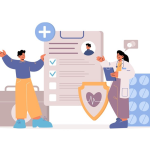
Biomedical Waste Management Guidelines For Healthcare Facilities
The effective management of healthcare waste is essential to ensure both public health and environmental protection, explore how healthcare facilities can effectively manage biomedical waste in line with Biomedical Waste Management. From waste segregation and treatment methods to disposal practices,
this guide offers essential information to help you prevent health hazards, protect the environment, and ensure regulatory compliance. Enhance your facility’s waste management protocols or stay updated on best practices.
Importance Of Waste Management
Proper management of healthcare waste is crucial to prevent health hazards and environmental pollution. Adhering to the guidelines helps in maintaining hygiene and safety in healthcare facilities. Here are more points highlighting the importance:
1. Preventing Health Hazards
- Infection Control: Proper disposal of medical waste reduces the risk of infections spreading within healthcare facilities and to the general public.
- Occupational Safety: Ensuring safe handling of waste protects healthcare workers from exposure to hazardous materials.
2. Environmental Protection
- Pollution Prevention: Proper treatment and disposal methods prevent environmental contamination from hazardous chemicals and biological agents.
- Sustainable Practices: Implementing waste segregation and recycling practices reduces the environmental footprint of healthcare facilities.
3. Regulatory Compliance
- Legal Obligations: Adhering to the Biomedical Waste Management Rules, 2016, ensures compliance with national regulations, avoiding legal penalties.
- Standards Adherence: Following standardized protocols helps in maintaining consistent and safe waste management practices across all healthcare facilities.
4. Training And Awareness
- Education: Regular training for healthcare workers on waste management protocols ensures that all staff members are aware of their responsibilities.
- Continuous Improvement: Ongoing review and improvement of waste management practices enhance the overall safety and efficiency of healthcare operations.
Classification Of Healthcare Waste
Healthcare waste is categorized to ensure proper management and disposal, minimizing health risks and environmental impact. It is classified into the following types:
Types Of Healthcare Waste
- Bio-Medical Waste: Includes any waste generated during the diagnosis, treatment, or immunization of human beings or animals.
- General Waste: Non-hazardous waste such as paper, food waste, and packaging materials.
- Other Wastes: Includes electronic waste, used batteries, and radioactive waste.
Categories Of Bio-Medical Waste
- Yellow Category: Human and animal anatomical waste, soiled waste, expired medicines, and microbiological waste.
- Red Categoryx: Contaminated recyclable waste.
- White Category: Waste sharps including metals.
- Blue Category: Broken or discarded glassware and metallic body implants.
Waste Segregation And Collection
Segregation Protocols
Waste must be segregated at the point of generation using colour-coded containers to prevent contamination and facilitate safe disposal.
Collection And Storage
- Time of Collection: Bio-medical waste should be collected daily at fixed intervals.
- Interim Storage: Waste should be stored in designated areas until disposal.
Transportation Of Bio-Medical Waste
In-House Transportation
Designated trolleys must be used for in-house transportation to ensure the safe and spill-free movement of waste within healthcare facilities.
Route Planning
Transportation routes should be carefully planned to avoid areas with high patient and visitor traffic, ensuring waste is moved efficiently and safely to central storage points.
Treatment And Disposal of Bio-Medical Waste
Effective treatment and disposal of biomedical waste are critical to preventing health hazards and environmental pollution:
Treatment Options
- Incineration: This method is used for high-risk waste such as human anatomical waste, ensuring complete destruction of pathogens.
- Autoclaving: Sterilizes medical waste using high-pressure steam, making it safe for disposal.
- Chemical Disinfection: Involves using chemical agents to disinfect waste, eliminating harmful microorganisms.
Spill Management Procedures
Mercury Spill Management
- Evacuation: Immediately evacuate the area to prevent exposure to toxic mercury vapours.
- Containment and Collection: Use tools like syringes and sticky tape to collect mercury, storing it in labelled, secure containers.
- Decontamination: Thoroughly clean the spill area with appropriate disinfectants to remove any residual mercury and prevent contamination.
Conclusion
Effective healthcare waste management is vital for preventing infections, protecting staff, and reducing environmental harm. By following proper segregation, collection, and disposal methods, healthcare facilities can maintain hygiene, safety, and comply with regulations like the Biomedical Waste Management Rules, 2016.
Regular training and awareness programs ensure that all staff understand their roles in managing waste responsibly. With consistent efforts and the right practices, healthcare facilities can create a safer environment for patients, workers, and the wider community.
Frequently Asked Questions (FAQs)
What Are The Key Responsibilities Of Healthcare Facilities In Waste Management?
Healthcare facilities must segregate waste at the point of generation, ensure proper collection and storage, transport waste safely, maintain detailed records, and comply with treatment and disposal standards.
How Should Biomedical Waste Be Segregated?
Biomedical waste should be segregated using colour-coded containers: yellow for human and animal anatomical waste, red for contaminated waste, white for sharps, and blue for glassware and metallic body implants.
What Are The Standards For Incineration Of Biomedical Waste?
Incineration standards include maintaining a combustion efficiency of at least 99.00%, with primary and secondary chamber temperatures of at least 800°C and 1050°C, respectively, and specific emission standards for particulate matter and other pollutants.
How Should Healthcare Facilities Handle Mercury Spills?
Facilities should evacuate the area, use protective equipment, collect mercury using syringes and sticky tape, and store contaminated materials in labelled yellow bags for proper disposal.
What Are The Record-Keeping Requirements For Biomedical Waste Management?
Facilities must maintain records of waste generation, treatment, disposal, staff training, health check-ups, and compliance reports for a minimum of five years.
Download The Official PDF From Here
Enhance Patient Care and NABH Compliance with LazyMonkey
LazyMonkey is your all-in-one solution for improving patient care, retaining more patients, and meeting NABH standards. Our powerful QR-based feedback tool enables you to capture real-time insights from patient feedback, discharge surveys, staff and doctor evaluations, and clinical research, while also streamlining inter-departmental communication.
Transform your healthcare facility today - reach out to us at hello@lazymonkey.in, or request a demo here!
Elevate Your Restaurant Experience with LazyMonkey
LazyMonkey’s QR-based feedback system helps you gather real-time insights from customers, track satisfaction levels, and enhance the dining experience. Get instant feedback on your menu, service, and ambience, and make data-driven improvements to boost repeat customers and reviews.
Improve your restaurant today – reach out to us at hello@lazymonkey.in, or request a demo here!
Empower Student Engagement and Campus Improvement with LazyMonkey
LazyMonkey offers a seamless way to gather student feedback, track satisfaction, and enhance campus life. From course evaluations to dorm feedback, our QR-based solution makes it easy to capture valuable insights and improve student retention.
Upgrade your university experience – contact us at hello@lazymonkey.in, or request a demo here!
Streamline Feedback and Drive Performance Across Your Enterprise/Franchise with LazyMonkey
Whether you manage one or multiple locations, LazyMonkey’s QR-based feedback system helps you gather real-time employee and customer feedback. Improve operational efficiency, track satisfaction, and make data-driven decisions to enhance brand consistency and growth.
Transform your franchise today – reach out to us at hello@lazymonkey.in, or request a demo here!
Enhance Customer Satisfaction and Service Standards in Banking with LazyMonkey
LazyMonkey empowers banks to capture real-time feedback from clients across branches. Improve customer experience, assess service quality, and ensure regulatory compliance with our QR-based solution, helping you retain clients and meet banking standards.
Elevate your bank’s customer care – contact us at hello@lazymonkey.in, or request a demo here!
Boost Customer Engagement and Mall Satisfaction with LazyMonkey
LazyMonkey’s QR-based feedback tool enables you to collect feedback from shoppers, track satisfaction, and enhance the mall experience. Gather insights on store services, cleanliness, and entertainment to create an unmatched customer journey.














